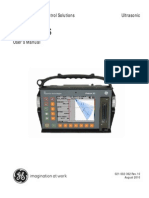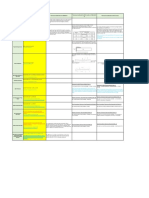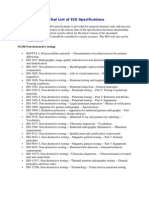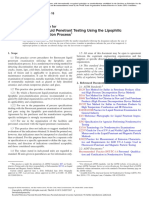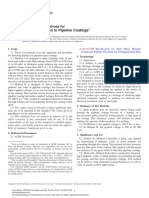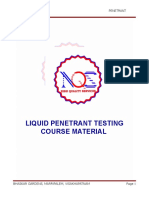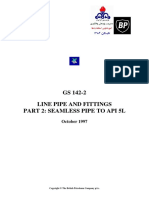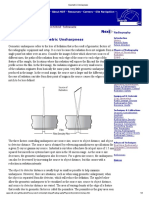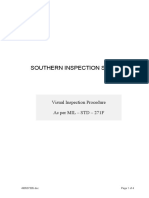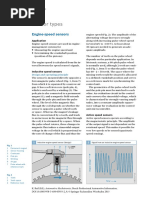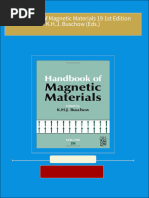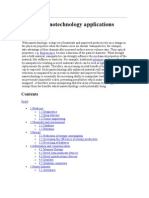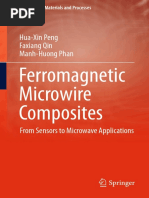Magnetic Flux Leakage Testing: Hapter
Magnetic Flux Leakage Testing: Hapter
Uploaded by
kingstonCopyright:
Available Formats
Magnetic Flux Leakage Testing: Hapter
Magnetic Flux Leakage Testing: Hapter
Uploaded by
kingstonOriginal Title
Copyright
Available Formats
Share this document
Did you find this document useful?
Is this content inappropriate?
Copyright:
Available Formats
Magnetic Flux Leakage Testing: Hapter
Magnetic Flux Leakage Testing: Hapter
Uploaded by
kingstonCopyright:
Available Formats
C
9
H A P T E R
Magnetic Flux Leakage
Testing
Satish S. Udpa, Michigan State University, East Lansing,
Michigan
Roderic K. Stanley, NDE Information Consultants,
Houston, Texas
PART 1. Introduction to Magnetic Flux Leakage
Testing
Magnetic flux leakage testing is part of the user’s quality assurance department. Oil
widely used family of electromagnetic field tubular goods are often tested at this
nondestructive techniques. Magnetic stage.
particle testing is a variation of flux
leakage testing that uses particles to show Inservice Testing
indications. When used with other
methods, magnetic tests can provide a Good examples of inservice applications
quick and relatively inexpensive are the testing of used wire rope, installed
assessment of the integrity of tubing, or retrieved oil field tubular goods
ferromagnetic materials. by independent facilities. Many
The theory and practice of laboratories also use magnetic techniques
electromagnetic techniques are discussed (along with metallurgical sectioning and
elsewhere in this volume. The origins of other techniques) for the assessment of
magnetic particle testing are described in steel products and prediction of failure
the literature1 and information that the modes.
practicing magnetic test engineer might
require is available from a variety of
manuals and journal articles.
The magnetic circuit and the means for Discontinuities2
producing the magnetizing force that Discontinuities can be divided into two
causes magnetic flux leakage are described general categories: those caused during
below. Theories developed for surface and manufacture in new materials and those
subsurface discontinuities are outlined caused after manufacture in used
along with some results that can be materials.
expected. Discontinuities caused during
manufacture include cracks, seams,
forging laps, laminations and inclusions.
Industrial Uses2 1. Cracking occurs when quenched steel
cools too rapidly.
Magnetic flux leakage testing is used in 2. Seams occur in several ways,
many industries to find a wide variety of depending on when they originate
discontinuities. Much of the world’s during fabrication.
production of ferromagnetic steel is tested 3. Discontinuities such as piping or
by magnetic or electromagnetic inclusions within a bloom or billet can
techniques. Steel is tested many times be elongated until they emerge as long
before it is used and some steel products tight seams or gouges during initial
are tested during use for safety and forming processes. They may later be
reliability and to maximize their length of closed with additional forming.
service. 4. Their metallurgical structures are often
different but the origin of
Production Testing manufactured discontinuities is not
usually taken into account when
Typical applications of magnetic flux rejecting a part.
leakage testing are by the steel producer, 5. Forging laps occur when gouges or fins
where blooms, billets, rods, bars, tubes created in one metal working process
and ropes are tested to establish the are rolled over at an angle to the
integrity of the final product. In many surface in subsequent processes.
instances, the end user will not accept 6. Inclusions are pieces of nonmagnetic
delivery of steel product without testing or nonmetallic materials embedded
by the mill and independent agencies. inside the metal during cooling.
Inclusions are not necessarily
Receiving Testing detrimental to the use of the material.
The end user often uses magnetic flux 7. The pouring and cooling processes can
leakage tests before fabrication. This test also result in lack of fusion within the
ensures the manufacturer’s claim that the steel. Such regions may be worked
product is within agreed specifications. into internal laminations.
Such tests are frequently performed by
independent testing companies or the end
228 Electromagnetic Testing
Discontinuities in used materials
include fatigue cracks, pitting corrosion,
erosion and abrasive wear.
Much steel is acceptable to the
producer’s quality assurance department if
no discontinuities are found or if
discontinuities are considered to be of a
depth or size less than some prescribed
maximum. Specifications exist for the
acceptance or rejection of such materials
and such specifications sometimes lead to
debate between the producer and the end
user. Discontinuities can either remain
benign or can grow and cause premature
failure of the part. Abrasive wear can turn
benign subsurface discontinuities into
detrimental surface breaking
discontinuities.
For used materials, fatigue cracking
commonly occurs as the material is
cyclically stressed. Fatigue cracks grow
rapidly under stress or in the presence of
corrosive materials such as hydrogen
sulfide, chlorides, carbon dioxide and
water. For example, drill pipe failure from
fatigue often initiates at the bases of pits,
at tong marks or in regions where the
tube has been worn by abrasion. Pitting is
caused by corrosion and erosion between
the steel and a surrounding or containing
fluid. Abrasive wear occurs in many steel
structures. Good examples are (1) the
wear on drill pipe caused by hard
formations when drilling crooked holes or
(2) the wear on both the sucker rod and
the producing tubing in rod pumping oil
wells. Specifications exist for the
maximum permitted wear under these
and other circumstances. In many
instances, such induced damage is first
found by automated magnetic techniques.
Steps in Magnetic Flux
Leakage Testing
There are four steps in magnetic flux
leakage testing: (1) magnetize the test
object so that discontinuities perturb the
flux, (2) scan the surface of the test object
with a magnetic flux sensitive detector,
(3) process the raw data from these
detectors in a manner that best
accentuates discontinuity signals and
(4) present the test results clearly for
interpretation. The following discussion
deals with the first step, producing the
magnetizing force.
Magnetic Flux Leakage Testing 229
PART 2. Magnetization Techniques
Successful testing requires the test object test object. The total magnetic flux φ
to be magnetized properly. The (weber) is given by:
magnetization can be accomplished using
one of several approaches: (1) permanent NI
magnets, (2) electromagnets and (1) φ =
S
(3) electric currents used to induce the
required magnetic field.
Excitation systems that use permanent where I is the current (ampere) in the coil,
magnets offer the least flexibility. Such N is the number of turns in the coil and
systems use high energy product S is the reluctance (ampere per weber) of
permanent magnet materials such as the magnetic circuit.
neodymium iron boron, samarium cobalt Reluctance S is the sum of the
and aluminum nickel. The major reluctance Sg of air gaps (between the test
disadvantage with such systems lies in the object and the yoke), test object
fact that the excitation cannot be reluctance Ss and yoke reluctance Sy. The
switched off. Because the magnetization is reluctance values of the air gaps, test
always turned on, it is difficult to insert object and yoke are given by Eqs. 2 to 4:
and remove the test object from the test
Lg
rig. Although the magnetization level can (2) Sg =
be adjusted using appropriate magnetic ag µ 0
shunts, it is awkward to do so.
Consequently, permanent magnets are
very rarely used for magnetization. Ls
(3) Ss =
Electromagnets, as well as electric as µ 0 (µ r )
currents, are used extensively to s
magnetize the test object. Figure 1 shows
an excitation system where the test object Ly
is part of a magnetic circuit energized by (4) Sy =
current passing through an excitation ay µ 0 ( µ r )
y
coil. The magnetic circuit passes through
a yoke made of a soft magnetic material where ax is the cross sectional area (square
and through a test object placed between meter) of the air gaps, test object or yoke;
the poles of the yoke. When the coil Lx is the length (meter) of the air gaps,
wound on the yoke carries current, the test object or yoke; µ0 is the permeability
resulting magnetomotive force drives of free space (µ0 = 4π × 10–7 H·m–1); µr is
magnetic flux through the yoke and the relative permeability; and subscripts g, s
and y denote the air gaps, test object and
yoke, respectively. Note that the magnetic
FIGURE 1. Electromagnetic yoke for circuit consists of two air gaps, one at
magnetizing of test object. each end of the test object. Both air gaps
need to be taken into account in
Coil calculating the total reluctance of the
magnetic circuit.
To obtain maximum sensitivity, it is
necessary to ensure that the magnetic flux
is perpendicular to the discontinuity. This
direction is in contrast to the orientation
in techniques that use an electric current
for inspection of a test object, where it
may be more advantageous to orient the
direction of current so that a
discontinuity would impede the current
as much as possible.
Because the orientation of the
discontinuity is unknown, it is necessary
Air gap where test to test twice with the yoke, in two
object is inserted directions perpendicular to each other. A
230 Electromagnetic Testing
grid is usually drawn on the test object to lines get concentrated within the test
facilitate the tests. object. Thus, the fields inside and outside
the test object are not the same. However,
two boundary conditions allow
assessment of the magnetic state of the
Magnetizing Coil test object. The fact that the tangential
A commonly used encircling coil is shown field is continuous across the air-to-metal
in Fig. 2. The field direction follows the interface allows measurement of H at the
right hand rule. (The right hand rule point R to yield the value of the
states that, if someone grips a rod, holds it tangential field at the test surface. In
out and imagines an electric current addition, because the normal component
flowing down the thumb, the induced of magnetic flux density B is continuous,
circular field in the rod would flow in the a tesla meter at point S will yield B inside
direction that the fingers point.) With no the test object at that point.
test object present, the field lines form Two totally different situations,
closed loops that encircle the current common in magnetic flux leakage testing,
carrying conductors. The value of the field are described below.
at any point has been established for a
great many coil configurations. The value Testing in Active Field
depends on the current in the coils, the
number of turns N and a geometrical In this technique, the test object is
factor. Calculation of the field from first scanned by probes near position R in
principles is generally unnecessary for Fig. 2, in the presence of an active field.
nondestructive testing; a hall element Air fields of 16 to 24 kA·m–1 (200 to
tesla meter will measure this field. 300 Oe) are commonly used. In this
Introduction of the test object into the situation, application of small fields is
field of the coil changes the field. The sufficient to cause magnetic flux leakage
metal becomes part of the magnetic from transversely oriented surface
circuit, with the result that, close to the breaking discontinuities. For subsurface
surface of the test object, magnetic field discontinuities or those on the inside
intensity H is lower than it would be if surface of tubes, larger fields are required.
the test object were removed. Again, a The inspector must experiment to
hall element tesla meter will show the optimize the applied field for the
field intensity at the test object. This particular discontinuity.
reduces the need for semiempirical
formulas. With the test object inserted, Testing in Residual Field
the flux density changes and the flux Test objects are first passed through the
coil field and then tested in the resulting
residual field. Elongating the coil and
FIGURE 2. Encircling coil using direct current placing the test object next to the inside
to produce magnetizing force. surface of the coil will expose the test
object to the largest field that the coil can
produce.
This technique is often used in
magnetic particle testing. The main
problem to avoid is the induction of so
much magnetic flux in the test object that
R the magnetic particles stand out like fur
along the field lines that enter and leave
P Q the test object, especially close to its ends.
S Optimum conditions require that the test
I object be somewhat less than saturated.
The inspector should experiment to
optimize the coil field requirements for
the test object because this field depends
on test object geometry.
Applied Direct Current
If an electric current is used to magnetize
Legend the test object, it may be more
I = electric current advantageous to orient the direction of
P, Q = points of discontinuities in example current in a manner where the presence
R = point at which magnetic field intensity H is
measured
of a discontinuity impedes the current
S = point at which magnetic flux density B is flow as much as possible. Bars, billets and
measured
Magnetic Flux Leakage Testing 231
tubes are often magnetized by application dictated by Faraday’s law, the result being
of a direct current I to their ends (Fig. 3). that an eddy current Ie flows around the
Figure 4 shows a system where the tube as shown in Fig. 6a, where the
current I is passed directly through a dashed line is the inner surface eddy
tubular test object to magnetize the test current and the solid line is the outer
object circularly. Figure 5 shows a central surface current.
conductor energized by a current source I, The net result is a lack of penetration
again, to establish a circular magnetic of the field caused by the capacitor
field intensity H (ampere per square discharge current Ic. For a centered rod, in
meter) in a tubular test object: effect, the magnetic field intensity in the
test object at radius r is given not by
I H = Ic·(2πr)–1 but rather by Eq. 6:
(5) H =
2 πa
Ic − Ie
(6) H (r ) =
where a is area (square meter). 2 πr
Capacitor Discharge Devices Here Ie is the amount of eddy current
(ampere) contained within the cylinder of
For the circular magnetization of tubes or
radius r (meter). Investigation of the effect
the longitudinal magnetization of the
of the eddy current is theoretically quite
ends of elongated test objects, a capacitor
complicated because of its effect on the
discharge device is sometimes used.3,4 The
capacitor discharge unit represents a
practical advance over battery packs and
consists of a capacitor bank charged to a
voltage V and then discharged through a FIGURE 4. Current carrying clamp electrodes used for testing
rod, a cable and a silicon controlled ferromagnetic tubular objects with small diameters.
rectifier of total resistance R.
The full system, considered
mathematically, also contains a variable
amount of inductance, so that if the Magnetic flux lines
current Ic were allowed to oscillate, it
would do so according to the theory of
LCR circuits (that is, circuits described by
inductance L, capacitance C and
resistance R). The theory is complicated Clamp
by the time required to magnetize the
material and to induce an eddy current in
the test object. Typical configurations Current I out
shown in Fig. 6 illustrate the complexity
of the situation. In the case of the
magnetization of a tube, the current Ic Current I in
first rises rapidly, inducing magnetic flux
in the tube. This time varying flux
changes rapidly and induces an
electromotive force in the tube, as
FIGURE 5. Simple technique for circumferential magnetization
of ferromagnetic tube.
FIGURE 3. Circumferential magnetization by application of
direct current: (a) rectilinear bar; (b) round bar; (c) tube.
r
(a)
I H
H
(b) I
H
(c) I
H Current source
I
Legend Legend
H = magnetic field intensity H = magnetic field intensity
I = electric current I = electric current
r = tube radius
232 Electromagnetic Testing
inductance, which in turn affects Ic. In 2. It is not possible to give simple rules
practice, however, measurement of the that relate Ic(max) to magnetization
magnetic flux density B in the material requirements. This relationship can be
will yield the final degree of shown with a magnetic flux meter.
magnetization of that material. 3. The eddy currents induced during
A good rule is that, if H(r) in Eq. 6 can pulse magnetization play an important
be maintained at about 3.2 kA·m–1 role in the result. They can shield
(40 Oe), the material will be magnetized midwall regions from magnetization.
almost to saturation and can be tested for 4. Larger capacitances at lower voltages
both surface and subsurface provide better magnetization than
discontinuities. Several other practical smaller capacitances at higher voltages
conclusions can be drawn from the above because larger capacitances at lower
discussion. voltages lead to longer duration pulses
1. Pulse duration plays a greater role and therefore to lower eddy currents.
than pulse amplitude Ic(max) in The lower voltage is an essential safety
determining the amount of flux feature for outdoor use. A maximum
induced in a test object. This is of 50 V is recommended.5
intuitively seen in direct current tests.
Magnitudes of Magnetic
FIGURE 6. Capacitor discharge configurations
causing magnetization perpendicular to
Flux Leakage Fields
current direction: (a) conductor internal to The magnitude of the magnetic flux
test object creates circular field; (b) flexible leakage field under active direct current
cable around test object creates longitudinal excitation naturally depends on the
field. applied field. An applied field of 3.2 to
4.0 kA·m–1 (40 to 50 Oe) inside the
(a) material can cause leakage fields with
Capacitor discharge unit peak values of tens of millitesla (hundreds
of gauss). However, in the case of residual
induction, the magnetic flux leakage
C SCR lc fields may be only a few hundred
microtesla (a few gauss). Furthermore,
with residual field excitation, an
interesting field reversal may occur,
depending on the value of the initial
le active field excitation and the dimensions
le of the discontinuity.
Circular field
(b) Optimal Operating Point
Consider raising the magnetization level
lc in a block of steel containing a
discontinuity (Fig. 7). At low flux density
C SCR levels, the field lines tend to crowd
together in the steel around the
discontinuity rather than go through the
nonmagnetic region of the discontinuity.
The field lines are therefore more crowded
above and below the discontinuity than
they are on the left or right. The material
can hold more flux as the permeability
rises, so there is no significant leakage
flux at the surfaces (Fig. 7a).
However, an increase in the number of
lines causes ∆B·(∆H)–1 to fall — the
material is becoming less permeable. At
Longitudinal field about this point, magnetic flux leakage is
Legend first noticed at the surfaces. Although the
C = capacitor lines are now closer together, representing
Ic = capacitor discharge current a higher magnetic flux density, they do
Ie = eddy current not have the ability to crowd closer
SCR = silicon controlled rectifier
together around the discontinuity where
the permeability is low.
At higher and higher values of applied
field, the permeability falls. It is, however,
Magnetic Flux Leakage Testing 233
FIGURE 7. Effects of induction on magnetic
flux lines at discontinuity: (a) no surface flux
leakage occurs where magnetic flux lines
are compressed at low levels of induction
around discontinuity; (b) lack of
compression at high magnetization results
in surface magnetic flux leakage.
(a)
(b)
Flux leakage
still large compared to the permeability of
air, so the reluctance of the path through
the discontinuity is still larger than
through the metal. As a result, magnetic
flux leakage at the outside surface helps
provide a sufficiently high flux density in
the material for the leakage of magnetic
flux from discontinuities (Fig. 7b) while
partially suppressing long range surface
noise.
For residual field testing, it is best to
ensure that the material is saturated. The
magnetic field starts to decay as soon as
the energizing current is removed.
234 Electromagnetic Testing
PART 3. Magnetic Flux Leakage Test Results
Magnetic flux leakage testing continues to induction direction makes it possible to
be one of the most popular orient the pickup coil so as to measure
nondestructive test techniques in any of the three leakage field components
industry. A number of factors, including selectively. Thus, a coil A whose axis is
low cost and simplicity of the data perpendicular to the surface of the test
interpretation process, contribute to this object (Fig. 8a), is sensitive only to the
popularity. The underlying principles and normal component. In contrast, the coil
modeling techniques are described in Fig. 8b is sensitive only to the
elsewhere in this volume. The discussion tangential component. Consider the case
below focuses on probes and excitation where the pickup coil is moving over the
schemes to detect and measure magnetic test object in the X direction. Making use
leakage fields. of the fact that φ = B·A, where B is the
magnetic flux density (tesla) and A is the
cross sectional area (square meter) of the
pickup coil, Eq. 7 can be rewritten:
Magnetic Flux Leakage
Probes (8) V =
− N dφ
= − NA
dB
The purpose of probes for magnetic dt dt
testing is to detect and possibly quantify dB dx
the magnetic flux leakage field generated = − NA ⋅
d x dt
by heterogeneities in the test object. The
leakage fields tend to be local and
This equation indicates that the output
concentrated near the discontinuities. The
of the pickup coil is proportional to the
leakage field can be divided into three
spatial gradient of the flux along the
orthogonal components: normal
direction of the coil movement as well as
(vertical), tangential (horizontal) and axial
the velocity of the coil. Two issues arise as
directions. Probes are usually either
a result.
designed or oriented to measure one of
these components. Typical plots of these 1. It is essential that the probe scan
components near discontinuities are velocity (relative to the test object)
shown in this volume’s chapter on probes. should be constant to avoid
A variety of probes (or transducers) are introducing artifacts into the signal
used in industry for detecting and through probe velocity variations.
measuring leakage fields. 2. The output is proportional to the
spatial gradient of the flux in the
direction of the coil.
Pickup Coils
The output of the pickup coil can be
One of the simplest and most popular
integrated for measurement of the leakage
means for detecting leakage fields is to use
flux density rather than of its gradient.
a pickup coil.6 Pickup coils consist of very
small coils that are either air cored or use
a small ferrite core. The voltage induced
in the coil is given by the rate of change FIGURE 8. Effect of pickup coil orientation on
of flux linkages associated with the pickup sensitivity to components of magnetic flux
coil. density: (a) coil sensitive to normal
component; (b) coil sensitive to tangential
− N dφ component.
(7) V =
dt
(a) (b)
where N is the number of turns in the
coil, V is the voltage induced in the coil Pickup coil
and φ is the magnetic flux (weber) linking Pickup coil
the coil. It must be mentioned that only
the component of the flux parallel to the
axis of the coil (or alternately
perpendicular to the plane of the coil) is
instrumental in inducing the voltage. This Test object Test object
Magnetic Flux Leakage Testing 235
Figure 9 shows the output of a pickup coil are described in this volume’s chapter on
and the signal obtained after integrating probes for electromagnetic testing.
the output.7 The coil is used to measure,
in units of tesla (or gauss), the magnetic Giant Magnetoresistive Probes
flux density B leaking from a rectangular
slot. Magnetic field sensitive devices called
The sensitivity of the pickup coil can giant magnetoresistive probes,8,9 at the most
be improved by using a ferrite core. Tools basic level, consist of a nonmagnetic layer
for designing pickup coils, as well as sandwiched between two magnetic layers.
predicting their performance, are The apparent resistivity of the structure
described elsewhere in this volume. varies depending on whether the
direction of the electron spin is parallel or
antiparallel to the moments of the
Magnetodiodes magnetic layers. When the moments
The magnetodiode is suitable for sensing associated with the magnetic layers are
leakage fields from discontinuities because aligned antiparallel, the electrons with
of its small size and its high sensitivity. spin in one direction (up) that are not
Because the coil probe is usually larger scattered in one layer will be scattered in
than the magnetodiode, it is less sensitive the other layer. This increases the
to longitudinally angled discontinuities resistance of the device. This is in contrast
than the magnetodiode is. However, the to the situation when the magnetic
coil probe is better than the moments associated with the layers are
magnetodiode for large discontinuities, parallel where the electrons that are not
such as cavities. scattered in one layer are not scattered in
the other layer, either.
Hall Effect Detectors Giant magnetoresistive probes use a
biasing current to push the magnetic
Hall effect detector probes are used layers into an antiparallel moment state
extensively in industry for measuring and the external field is used to overcome
magnetic flux leakage fields in units of the effect of the bias. The resistance of the
tesla (or gauss). Hall effect detector probes device, therefore, decreases with
increasing field intensity values. Figure 10
shows a typical response of a giant
magnetoresistive probe.
FIGURE 9. Pickup coil and signal integrator (magnetic flux
leakage) output for rectangular discontinuity.7
Magnetic Tape
0.3 (3) 30 For the testing of flat surfaces, magnetic
tape can be used. The tape is pressed to
Magnetic flux density B, T (kG)
Magnetic flux the surface of the magnetized billet and
leakage then scanned by small probes before
0.2 (2) 20 being erased. This technique is sometimes
called magnetography.
Output from search coil (mV)
0.1 (1) 10
FIGURE 10. Resistance versus applied field for
2 µm (8 × 10–5 in.) wide strip of
antiferromagnetically coupled, multilayer
0 0 test object composed of 14 percent giant
magnetoresistive material.9
Discontinuity 4.2
width
–10
4.1
Resistance (kΩ)
Search coil output 4.0
3.9
–20
3.8
3.7
–30 3.6
0 2 4 6 8 10
(8) (16) (24) (32) (40) –32 –16 0 16 32
(–0.4) (–0.2) (0.2) (0.4)
Coil position mm (10–2 in.)
Applied magnetic field, kA·m–1 (kOe)
236 Electromagnetic Testing
In automated systems, magnetic tape Wet Testing. Wet techniques are used for
can be fed from a spool. The signals can detecting relatively fine cracks. The
be read and the tape can be erased and magnetic particles are suspended in a
reused. liquid (usually oil or water) usually
Unfortunately, the tangential leakage sprayed on the test object. Particle sizes
field intensity at the surface of the are significantly smaller than those used
material is not constant. To optimize the with dry techniques and vary in size
response, the amplification of the signals within a normal distribution, with most
can be varied. particles measuring from 5 to 20 µm
Scabs or slivers projecting from the test (2 × 10–4 to 8 × 10–4 in.). As in the case of
surface can easily tear the tape dry powders, the ferromagnetic particles
are coated with either reflective or
fluorescent pigments. More information
on this subject is available elsewhere.1
Magnetic Particles
Magnetic particles are one of the most Imaging of Magnetic Particle
popular means used in industry for Indications
detecting magnetic fields. Indeed,
magnetic particle testing is so popular The magnetic particle distribution can be
that an entire volume of the examined visually after illuminating the
Nondestructive Testing Handbook is devoted surface or the surface can be scanned with
to the subject.1 The descriptions below are a flying spot system or imaged with a
therefore cursory. charge coupled device camera.
Magnetic particle testing involves the Flying Spot Scanners. To illuminate the
application of magnetic particles to the test object (Fig. 11), flying spot
test object after it is magnetized by using scanners10,11 use a narrow beam of
an appropriate technique. The radiation — visible light for
ferromagnetic particles preferentially nonfluorescent particles and ultraviolet
adhere to the surface of the test object in radiation for fluorescent ones. The source
areas where the flux is diverted, or leaks of the beam is usually a laser. The
out. The magnetic flux leakage near wavelength of the beam is chosen
discontinuities causes the magnetic carefully to excite the pigment of the
particles to accumulate in the region and magnetic particles. The incidence of the
in some cases form an outline of the radiation beam on the test object can be
discontinuity. Heterogeneities can varied by moving the scanning mirror.
therefore be detected by looking for The photocell does not sense any light
indications of magnetic particle when the test object is scanned by the
accumulations on the surface of the test narrow radiation beam until the beam is
object either with the naked eye or directly incident on the magnetic particles
through a camera. The indications are adhering to the test object near a
easier to see if the particles are bright and discontinuity. When this occurs, a large
reflective. Alternately, particles that amount of light is emitted, called
fluoresce under ultraviolet or visible fluorescence if excited by ultraviolet
radiation may be used. The test object has radiation. The fluorescence is detected by
to be viewed under appropriate levels of a single phototube equipped with a filter
illumination with radiation of appropriate that renders the system blind to the
wavelength (visible, ultraviolet or other).
Application Techniques FIGURE 11. Flying spot scanner for automated magnetic
Magnetic particles are applied to the particle testing.10,11
surface by two different techniques in
industry. Pattern recognition
Scanning mirror electronics
Dry Testing. Dry techniques use particles
applied in the form of a fine stream or an Laser
aerosol. They consist of high permeability Light collecting mirror
ferromagnetic particles coated with either
reflective or fluorescent pigments. The Amplifier
particle size is chosen according to the
Threshold
dimensions of the discontinuity sought. Photocell gate
Particle diameters range from ≤50 to
180 µm (≤0.002 to 0.007 in.). Finer Stationary mirror
Fluorescent indication
particles are used for detecting smaller
discontinuities where the leakage
intensity is low. Dry techniques are used
extensively for testing welds and castings Signal output
where heterogeneities of interest are
relatively large.
Magnetic Flux Leakage Testing 237
radiation from the irradiating source. The Finite Element Techniques
output of the photocell is suitably
An advance in magnetic theory since
amplified, digitized and processed by a
1980 has been the introduction of finite
computer.
element computer codes to the solution
Charge Coupled Devices. An alternative of magnetostatic problems. Such codes
approach is to flood the test object with came originally from a desire to minimize
radiation whose wavelength is carefully electrical losses from electromagnetic
chosen to excite the pigment of the machinery but soon found application in
magnetic particles. Charge coupled device magnetic flux leakage theory. The
cameras,12,13 equipped with optical filters advantage of such codes is that, once set
that render the camera blind to radiation up, discontinuity leakage fields can be
from the source but are transparent to calculated by computer for any size and
light emitted by the magnetic particles, shape of discontinuity, under any
can be used to image the surface very magnetization condition, so long as the
rapidly. B,H curve for the material is known.
In very simple terms, charge coupled In the models of magnetic flux leakage
devices each consist of a two-dimensional discussed so far, the implicit assumptions
array of tiny pixels that each accumulates are (1) that the field within a
a charge corresponding to the number of discontinuity is uniform and (2) that the
photons incident on it. When a readout nonlinear magnetization characteristic
pulse is applied to the device, the (B,H curve) of the tested material can be
accumulated charge is transferred from ignored. Much of the early pioneering
the pixel to a holding or charge transfer work in magnetic flux leakage modeling
cell. The charge transfer cells are used these assumptions to obtain closed
connected in a manner that allows them form solutions for leakage fields.
to function as a bucket brigade or shift The solutions of classical problems in
register. The charges can, therefore, be electrostatics have been well known to
serially clocked out through a physicists for almost a century and their
charge-to-voltage amplifier that produces magnetostatic analogs were used to
a video signal. approximate discontinuity leakage fields.
In practice, charge coupled device Such techniques work reasonably well
cameras can be interfaced to a personal when the permeability around a
computer through frame grabbers, which discontinuity is constant or when
are commercially available. Vendors of nonlinear permeability effects can be
frame grabbers usually provide software ignored. The major problem that remains
that can be executed on the personal is how to deal with real discontinuity
computer to process the image. Image shapes often impossible to handle by
processing software can be used for classical techniques.
example to improve contrast, highlight Such deficiencies are overcome by the
the edges of discontinuity or to minimize use of computer programs written to
noise in the image. allow for nonlinear permeability effects
around oddly shaped discontinuities.
Specifically, computerized finite element
techniques, originally developed for
Test Calculations studying magnetic flux distributions in
In determining the magnetic flux leakage electromagnetic machinery, have also
from a discontinuity, certain conditions been developed for nondestructive
must be known: (1) the discontinuity’s testing. Both active and residual
location with respect to the surfaces from excitation are discussed above. The
which measurements are made, (2) the extension of the technique to include
relative permeability of the material eddy currents is detailed elsewhere in this
containing the discontinuity and (3) the volume.
levels of magnetic field intensity H and
magnetic flux density B in the vicinity of
the discontinuity. Even with this
knowledge, the solution of the applicable
field equations (derived from Maxwell’s
equations of electromagnetism) is difficult
and is generally impossible in closed
algebraic form. Under certain
circumstances, such as those of
discontinuity shapes that are easy to
handle mathematically, relatively simple
equations can be derived for the magnetic
flux leakage if simplifying assumptions are
made. This simplification does not apply
to subsurface inclusions.
238 Electromagnetic Testing
PART 4. Applications of Magnetic Flux Leakage
Testing14
Magnetic flux leakage testing is a suited for pumping well sucker rods and
commonly used technique. Signals from other elongated oil field test objects.
probes are processed electronically and After a well is drilled, the sides of the
presented in a manner that indicates the well are lined with a relatively thin steel
presence of discontinuities. Although casing material, which is then cemented
some techniques of magnetic flux leakage in. This casing can be tested only from
testing may not be as sophisticated as the inside surface. The cylindrical
others, it is probable that more geometry of the casing permits the flux
ferromagnetic material is tested with loop to be easily calculated so that
magnetic flux leakage than with any other magnetic saturation of the well casing is
technique. achieved.
Magnetizing techniques have evolved As with inservice well casing, buried
to suit the geometry of the test objects. pipelines are accessible only from the
The techniques include yokes, coils, the inside surface. The magnetic flux loop is
application of current to the test object the same as for the well casing test
and conductors that carry current through system. In this case, a drive mechanism
hollow test objects. Many situations exist must be provided to propel the test
in which current cannot be applied system through the pipeline.
directly to the test object because of the
possibility of arc burns. Design Threaded Regions of Pipe
considerations for magnetization of test
objects often require minimizing the An area that requires special attention
reluctance of the magnetic circuit, during the inservice testing of drill pipe is
consisting of (1) the test object, (2) the the threaded region of the pin and box
magnetizing system and (3) any air gaps connections. Common problems that
that might be present. occur in these regions include fatigue
cracking at the roots of the threads and
stretching of the thread metal. Automated
systems that use both active and residual
Test Object Configurations magnetic flux techniques can be used for
detecting such discontinuities.
Short Asymmetrical Objects
Ball Bearings and Races
A short test object with little or no
symmetry may be magnetized to Systems have been built for the
saturation by passing current through it magnetization of both steel ball bearings
or by placing it in an encircling coil. If and their races. One such system uses
hollow, a conductor can be passed specially fabricated hall elements as
through the test object and magnetization detectors.
achieved by any of the standard
techniques (these include half-wave and Relatively Flat Surfaces
full-wave rectified alternating current, The testing of welded regions between flat
pure direct current from battery packs or or curved plates is often performed using
pulses from capacitor discharge systems). a magnetizing yoke. Probe systems
For irregularly shaped test objects, testing include coils, hall effect detectors,
by wet or dry magnetic particles is often magnetic particles and magnetic tape.
performed, especially if specifications
require that only surface breaking
discontinuities be found.
Discontinuity Mechanisms
Elongated Objects In the metal forming industry,
The cylindrical symmetry of elongated discontinuities commonly found by
test objects such as wire rope permits the magnetic flux leakage techniques include
use of a relatively simple flux loop to overlaps, seams, quench cracks, gouges,
magnetize a relatively short section of the rolled-in slugs and subsurface inclusions.
rope. Encircling probes are placed at some In the case of tubular goods, internal
distance from the rope to permit the mandrel marks (plug scores) can also be
passage of splices. Such systems are also identified when they result in remaining
Magnetic Flux Leakage Testing 239
wall thicknesses below some specified
minimum. Small marks of the same type
can also act as stress raisers and cracking
Typical Magnetic Flux
can originate from them during quench Leakage Techniques
and temper procedures. Depending on the
use to which the material is put,
subsurface discontinuities such as porosity
Short Parts
and laminations may also be considered For many short test objects, the most
detrimental. These types of discontinuities convenient probe to use is the magnetic
may be acceptable in welds where there particle. The test object can be inspected
are no cyclic stresses but may cause for surface breaking discontinuities during
injurious cracking when such stresses are or after it has been magnetized to
present. saturation. For active field testing, the test
In the metal processing industries, object can be placed in a coil carrying
grinding especially can lead to surface alternating current and sprayed with
cracking and to some changes in surface magnetic particles. Or it can be
metallurgy. Such discontinuities as magnetized to saturation by a direct
cracking have traditionally been found by current coil and the resulting residual
magnetic flux leakage techniques, induction can be shown with magnetic
especially wet magnetic particle testing. particles. In the latter case, the induction
Service induced discontinuities include in the test object can be measured with a
cracks, corrosion pitting, stress induced flux meter. Wet particles perform better
metallurgy changes and erosion from than dry ones because there is less
turbulent fluid flow or metal-to-metal tendency for the wet particles to fur (that
contact. In those materials placed in is, to stand up like short hairs) along the
tension and under torque, fatigue field lines that leave the test object. These
cracking is likely to occur. A discontinuity techniques will detect transversely
that arises from metal-to-metal wear is oriented, tight discontinuities.
sucker rod wear in tubing from producing The magnetic flux leakage field
oil wells. Here, the pumping rod can rub intensity from a tight crack is roughly
against the inner surface of the tube and proportional to the magnetic field
both the rod and tube wear thin. In wire intensity Hg across the crack, multiplied
rope, the outer strands will break after by crack width Lg. If the test is performed
wearing thin and inner strands sometimes in residual induction, the value of Hg
break at discontinuities present when the (which depends on the local value of the
rope was made. Railroad rails are subject demagnetization field in the test object)
to cyclic stresses that can cause cracking will vary along the test object. Thus, the
to originate from otherwise benign sensitivity of the technique to
internal discontinuities. discontinuities of the same geometry
Loss of metal caused by a conducting varies along the length of the test object.
fluid near two slightly dissimilar metals is For longitudinally oriented
a very common form of corrosion. The discontinuities, the test object must be
dissimilarity can be quite small, as for magnetized circumferentially. If the test
example, at the heat treated end of a rod object is solid, then current can be passed
or tube. The result is preferential through the test object, the surface field
corrosion by electrolytic processes, intensity being given by Ampere’s law:
compounded by erosion from a contained
∫H
flowing fluid. Such loss mechanisms are
(9) dl = I
common in subterranean pipelines,
installed petroleum well casing and in
refinery and chemical plant tubing. where dl is an element of length (meter),
The stretching and cracking of threads H is the magnetic field intensity (ampere
is a common problem. For example, when per meter) and I is the current (ampere) in
tubing, casing and drill pipe are the test object.
overtorqued at the coupling, the threads If the test object is a cylindrical bar, the
exist in their plastic region. This causes symmetry of the situation allows H to be
metallurgical changes in the metal and constant around the circumference, so the
can create regions where stress corrosion closed integral reduces:
cracking takes place in highly stressed
areas at a faster rate than in areas of less
stress. Couplings between tubes are a (10) 2π R H = I
good example of places where material
may be highly stressed. Drill pipe threads or:
are a good example of places where such
stress causes plastic deformation and I
(11) H =
thread root cracking. 2π R
240 Electromagnetic Testing
where R is the radius (meter) of the transverse discontinuities, such as
cylindrical test object. A surface field ultrasonic or eddy current techniques.
intensity that creates an acceptable
magnetic flux leakage field from the Alternating Current versus Direct
minimum sized discontinuity must be
used. Such fields are often created by Current Magnetization
specifying the amperage per meter of the Alternating current magnetization is more
test object’s outside diameter. suitable for detection of outer surface
discontinuities because it concentrates the
Transverse Discontinuities magnetic flux at the surface. For equal
magnetizing forces, an alternating current
Because of the demagnetizing effect at the field is better for detecting outside surface
end of a tube, automated magnetic flux imperfections but a direct current field is
leakage test systems do not generally better for detecting imperfections below
perform well when scanning for the surface.
transverse discontinuities at the ends of In practice, the ends of tubes are tested
tubes. The normal component Hy of the for transverse discontinuities by the
field outside the tube is large and can following magnetic flux leakage
obscure discontinuity signals. Test techniques.
specifications for such regions often
include the requirement of additional 1. Where there is a direct current active
longitudinal magnetization at the tube field from an encircling coil, magnetic
ends and subsequent magnetic particle particles are thrown at the tested
tests during residual induction. This material while it is maintained at a
situation is equivalent to the high level of magnetic induction by a
magnetization and testing of short test direct current field in the coil. This
objects as outlined above. technique is particularly effective for
The flux lines must be continuous and internal cracks. Fatigue cracks in drill
must therefore have a relatively short pipe are often found by this
path in the metal. Large values of the technique.
magnetizing force at the center of the coil 2. Where there is an alternating current
are usually specified. Such values depend active field from an encircling coil,
on the weight per unit length of the test magnetic particles are thrown at the
object because this quantity affects the tested material while it lies inside a
ratio of length L to diameter D. Where the coil carrying alternating current. Using
test object is a tube, the L·D–1 ratio is 50 or 60 Hz alternating current, the
given by the length between the poles penetration of the magnetic field into
divided by twice the wall thickness of the the material is small and the
tube. (The distance L from pole to pole technique is good only for the
can be longer or shorter than the actual detection of outside surface
length of the test object and must be discontinuities.
estimated by the operator.) As a rough When tests for both outer surface and
example, with L = 460 mm (18 in.) and inner surface discontinuities are necessary,
D = 19 mm (0.75 in.), the L·D–1 ratio it may be best to test first for outer surface
is 24. discontinuities with an alternating current
The effective permeability of the metal field, then for inner surface
under test is small because of the large discontinuities with a direct current field.
demagnetization field created in the test
object by the physical end of the test Liftoff Control of Scanning Head
object. An empirical formula is often used
to calculate approximately the effective To obtain a stable detection of
permeability µ: discontinuities, liftoff between the probe
and the surface of the material must be
kept constant. Usually liftoff is kept
L
(12) µ = 6 − 5 constant by contact of the probe with the
D surface but the probe tends to wear with
this technique. A magnetic floating
so effective permeability µ = 139 in the technique has been used for noncontact
above example. scanning. In this technique, liftoff is
For wet magnetic particle testing, the measured by a gap probe and the probe
surface tension of the fluids that carry the holder is moved by a voice coil motor,
particles is large enough to confine the controlled by the gap signal.15 This system
particles to the surface of the test object. and related technology are described in
This is not the case with dry particles, this volume’s chapter on primary metals
which have the tendency to stand up like applications.
fur along lines of magnetizing force.
In many instances, it may be better to
use some other test technique for
Magnetic Flux Leakage Testing 241
If the material is generally horizontal,
Particular Applications some form of drive mechanism is
required. Because the test device (a robotic
crawler) may move at differing speeds, the
Wire Ropes magnetic flux leakage probe should have
a signal response independent of velocity.
An interesting example of an elongated
For devices that operate vertically, such as
steel product inspected by magnetic flux
petroleum well casing test systems, coil
leakage testing is wire rope. Such ropes are
probes can be used if the tool is pulled
used in the construction, marine and oil
from the bottom of the well at a constant
production industries, in mining
speed. In both types of instrument, the
applications and elevators for personnel
probes are mounted in pads pressed
and raw material transportation. Testing is
against the inner wall of the pipe.
performed to determine cross sectional
Because both line pipe and casing are
loss caused by corrosion and wear and to
manufactured to outside diameter size,
detect internal and external broken wires.
there is a range of inside diameters for
The type of flux loop used (electromagnet
each pipe size. Such ranges may be found
or permanent magnet) can depend on the
in specifications. To make the air gap as
accessibility of the rope. Permanent
small as possible, soft iron attachments
magnets might be used where taking
can be screwed to the pole pieces.
power to an electromagnet might cause
For the pipeline crawler, a recorder
logistic or safety problems.
package is added and the signals from
By making suitable estimates of the
discontinuities are tape recorded. When
parameters involved, a reasonably good
the tapes are retrieved and played back,
estimate of the flux in the rope can be
the areas of damage are located. Pipe
made. Because discontinuities can occur
welds provide convenient magnetic
deep inside the rope material, it is
markers. With the downhole tool, the
essential to maintain the rope at a high
magnetic flux leakage signals are sent up
value of magnetic flux density, 1.6 to
the wire line and processed in the logging
1.8 T (16 to 18 kG). Under these
truck at the wellhead.
conditions, breaks in the inner regions of
A common problem with this and
the rope will produce magnetic flux
other magnetic flux leakage equipment is
leakage at the surface of the rope.
the need to determine whether the signals
The problem of detecting magnetic
originate from discontinuities on the
flux leakage from inner discontinuities is
inside or the outside surface of the pipe.
compounded by the need to maintain the
Production and transmission companies
magnetic probes far enough from the rope
require this information because it lets
for splices in the rope to pass through the
them determine which form of corrosion
test head. Common probes include hall
control to use. The test shoes sometimes
effect detectors and encircling coils.
contain a high frequency eddy current
The cross sectional area of the rope can
probe system that responds only to inside
be measured by sensing changes in the
surface discontinuities. Thus, the
magnetic flux loop that occur when the
occurrence of both magnetic flux leakage
rope gets thinner. The air gap becomes
and eddy current signals indicates an
larger and so the value of the field
inside surface discontinuity whereas the
intensity falls. This change can easily be
occurrence of a magnetic flux leakage
sensed by placing hall effect probes
signal indicates only an outside surface
anywhere within the magnetic circuit.
discontinuity.
Problems with this form of testing
Internal Casing or Pipelines include the following.
The testing of inservice well casing or 1. The magnetic flux leakage system
buried pipelines is often performed by cannot measure elongated changes in
magnetic flux leakage techniques. Various wall thickness, such as might occur
types of wall loss mechanisms occur, with general erosion.
including internal and external pitting, 2. If there is a second string around the
erosion and corrosion caused by the tested string, the additional metal
proximity of dissimilar metals. contributes to the flux loop, especially
From the point of view of magnetizing in areas where the two strings touch.
the pipe metal in the longitudinal 3. A relatively large current must be sent
direction, the two applications are down the wire line to raise the pipe
identical. The internal diameters and wall to saturation. Temperatures in
metal masses involved in the magnetic deep wells can exceed 200 °C (325 °F).
flux loop indicate that some form of 4. The tool may stick downhole or
active field excitation must be used. underground if external pressures
Internal diameters of typical production cause the pipe to buckle.
or transportation tubes range from about
100 mm (4 in.) to about 1.2 m (4 ft).
242 Electromagnetic Testing
Cannon Tubes discontinuity depths, the automatic
readout of these two systems still
In elongated tubing, the presence of
represents an improvement over visual or
rifling affects the ability to perform a
magnetic particle testing.
good test, especially for discontinuities
One technique, often called
that occur in the roots of the rifling.
magnetography, for the detection of
Despite the presence of extraneous signals
discontinuities uses a belt of flux sensitive
from internal rifling, however, rifling
material, magnetic tape, to record
causes a regular magnetic flux leakage
indications. Discontinuity fields
signal that can be distinguished from
magnetize the tape, which is then
discontinuity signals. As a simulated
scanned with an array of microprobes or
discontinuity is made narrower and
hall effect detectors. Finally, the tape
shallower, the signal will eventually be
passes through an erase head before
indistinguishable from the rifle bore
contacting the billet again. Because the
noise. In magnetic flux leakage testing,
field intensity at the corners is less than at
cannon tubes can be magnetized to
the center of the flat billet face, a
saturation and scanned with hall elements
compensation circuit is required for equal
to measure residual induction.
sensitivity across the entire surface.
Round Bars and Tubes
In some test systems, round bars and
tubes have been magnetized by an
Damage Assessment
alternating current magnet and rotated In most forms of magnetic flux leakage
under the magnet poles. Because the testing, discontinuity dimensions cannot
leakage flux from surface discontinuities is be accurately measured by using the
very weak and confined to a small area, signals they produce. The final signal
the probes must be very sensitive and results from more than one dimension
extremely small. The system uses a and perhaps from changes in the
differential pair of magnetodiodes to magnetic properties of the metal
sense leakage flux from the discontinuity. surrounding the discontinuity.
The differential output of these twin Signal shapes differ widely, depending
probes is amplified to separate the leakage on location, dimensions and
flux from the background flux. In this magnetization level. It is therefore
system, pipes are fed spirally under the impossible to accurately assess the damage
scanning station, which has an in the test object with existing
alternating current magnet and an array equipment. Under special circumstances
of probe pairs. The system usually has (for example, when surface breaking
three scanning stations to increase the cracks can be assumed to share the same
test rate. width and run normal to the material
In one similar system, round billets are surface), it may be possible to correlate
rotated by a set of rollers while the billet magnetic flux leakage signals and
surface is scanned by a transducer array discontinuity depths. This correlation is
moving straight along the billet axis. normally impossible.
Seamless pipes and tubes are made from Commercially available equipment
the round billets. does not reconstruct all the desired
In another tube test system, the discontinuity parameters from magnetic
transducers rotate around the pipe as the flux leakage signals. For example, the
pipe is conveyed longitudinally. signal shape caused by a surface breaking
Overlapping elliptical printed circuit coils forging lap is different from that caused
are used instead of magnetodiodes and are by a perpendicular crack but no
coupled to electronic circuits by slip rings. automated equipment uses this difference
The system can separate seams into to distinguish between these
categories according to crack depth. discontinuities.
As with many forms of nondestructive
testing, the detection of a discontinuity
Billets and subsequent followup by either
A relatively common problem with square nondestructive or destructive methods
billets is elongated surface breaking pose no serious problems for the
cracks. By magnetizing the billet inspector. Ultrasonic techniques,
circumferentially, magnetic flux leakage especially a combination of shear wave
can be induced in the resulting residual and compression wave techniques, work
magnetic field. well for discontinuity assessment after
Magnetic flux leakage systems for magnetic flux leakage has detected them.
testing tubes exhibit the same general In some cases, however, the discontinuity
ability to classify seam depth. It is is forever hidden. Such is very often the
generally accepted that even with the lack case for corrosion in downhole and
of correlation between some of the subterranean pipes.
instrument readings and the actual
Magnetic Flux Leakage Testing 243
References
1. Nondestructive Testing Handbook, 11. Flaherty, J. and E.J. Strauts. “Automatic
second edition: Vol. 6, Magnetic Particle Scanning of Fluorescent Indications.”
Testing. Columbus, OH: American Proceedings of the ASM Metals Show.
Society for Nondestructive Testing Materials Park, OH: ASM International
(1989). (October 1971).
2. Stanley, R.K. Section 21, “Diverted 12. Bloke, M.M., N. Sampat and J. Canosa.
Flux Theory.” Nondestructive Testing Sensors and Camera Systems for Systems
Handbook, second edition: Vol. 4, for Scientific Industrial and Digital
Electromagnetic Testing. Columbus, OH: Photography Applications. Bellingham,
American Society for Nondestructive WA: SPIE Press (2001).
Testing (1986): p 607-630. 13. Donati, S. Photodetectors: Devices,
3. Stanley, R.K. and G.L. Moake. Circuits and Applications. Upper Saddle
“Inspecting Oil Country Tubular River, NJ: Prentice Hall (2000).
Goods Using Capacitor Discharge 14. Stanley, R.K., T. Hiroshima and
Systems.” Materials Evaluation. Vol. 41, M.L. Mester. Section 22, “Diverted
No. 7. Columbus, OH: American Flux Applications.” Nondestructive
Society for Nondestructive Testing Testing Handbook, second edition:
(1983): p 779-782. Vol. 4, Electromagnetic Testing.
4. Moake, G.L. and R.K. Stanley. Columbus, OH: American Society for
“Capacitor Discharge Magnetization of Nondestructive Testing (1986):
Oil Country Tubular Goods.” p 631-651.
Electromagnetic Methods of 15. Sakamoto, T. and T. Hiroshima.
Nondestructive Testing. New York, NY: “Rotating Eddy Current Machine for
Gordon and Breach (1985): p 151-160. Hot Steel Rods and Wires.” Paper 5.
5. NFPA 70, National Electric Code, QualTest-2 Conference Proceedings
2002 edition. Quincy, MA: National [Dallas, TX, October 1983]. Columbus,
Fire Prevention Association (2001). OH: American Society for
6. Beissner, R.E., G.A. Matzkanin and Nondestructive Testing (1983): p 1-11.
C.M. Teller. NDE Applications of
Magnetic Leakage Field Methods: A State
of the Art Survey. San Antonio, TX:
Southwest Research Institute (1980). Bibliography
7. Owston, C.N. “The Magnetic Leakage
Field Technique of NDT.” British ASTM E 570, Standard Practice for Flux
Journal of Non-Destructive Testing. Leakage Examination of Ferromagnetic
Vol. 16, No. 6. Northampton, United Steel Tubular Products. West
Kingdom: British Institute of Conshohocken, PA: ASTM
Non-Destructive Testing International (1997).
(November 1974): p 162-168. ASTM E 1571, Standard Practice for
8. Daughton, J., J. Brown, R. Beech, Electromagnetic Examination of
A. Pohm and W. Kude. “Magnetic Ferromagnetic Steel Wire Rope. West
Field Sensors Using GMR Multilayer.” Conshohocken, PA: ASTM
IEEE Transactions on Magnetics. Vol. 30, International (2001).
No. 6. New York, NY: Institute of Hwang, J.H. Defect Characterization by
Electrical and Electronics Engineers Magnetic Leakage Fields. Ph.D.
(1994): p 4608-4610. dissertation. Fort Collins, CO:
9. Smith, C. and J. Daughton. “Low-Field Colorado State University (1975).
Magnetic Sensing with GMR Sensors.” Lord, W., J.M. Bridges, W. Yen and
Proceedings of the Sensors Expo R. [P. Samy]. “Residual and Active
[Baltimore, MD, May 1999]. Leakage Fields around Defects in
Cleveland, OH: Advanstar Ferromagnetic Materials.” Materials
Communications (1999). Evaluation. Vol. 36, No. 7. Columbus,
10. Flaherty, J. and E.J. Strauts. United OH: American Society for
States Patent 3 774 162, Laser Scan Nondestructive Testing (July 1978):
Testing System Having Pattern p 47-54.
Recognition Means (1973).
244 Electromagnetic Testing
Mackintosh, D.D., D.L. Atherton,
P.C. Porter and A. Teitsma. “Test Rigs
for Magnetic Flux Leakage Inspection
Tools for Pipelines.” Materials
Evaluation. Vol. 50, No. 1. Columbus,
OH: American Society for
Nondestructive Testing (January 1992):
p 13-17.
McClurg, G.O. “Theory and Application
of Coil Magnetization.” Nondestructive
Testing. Vol. 13, No. 1. Columbus, OH:
American Society for Nondestructive
Testing (January-February 1955):
p 23-25.
Shannon, R.W.E. and L. Jackson. “Flux
Leakage Testing Applied to
Operational Pipelines.” Materials
Evaluation. Vol. 46, No. 12. Columbus,
OH: American Society for
Nondestructive Testing (November
1988): p 1516-1518, 1520-1522, 1524.
Stanley, R.K. “Circumferential
Magnetization of Tubes and the
Measurement of Flux Density in Such
Materials.” Materials Evaluation.
Vol. 44, No. 8. Columbus, OH:
American Society for Nondestructive
Testing (July 1986): p 966-970.
Stanley, R.K. “Simple Explanation of the
Theory of the Total Magnetic Flux
Method for the Measurement of
Ferromagnetic Cross Sections.”
Materials Evaluation. Vol. 53, No. 1.
Columbus, OH: American Society for
Nondestructive Testing (January 1995):
p 72-75.
Magnetic Flux Leakage Testing 245
You might also like
- DIN EN 10002-1-2001 金属材料.拉力试验.第1部分室温下的试验方法 PDFDocument54 pagesDIN EN 10002-1-2001 金属材料.拉力试验.第1部分室温下的试验方法 PDFakifNo ratings yet
- Nondestructive Examinations: Standard Terminology ForDocument39 pagesNondestructive Examinations: Standard Terminology Forcatalina mazoNo ratings yet
- Mandatory Appendix Viii - Asme VDocument3 pagesMandatory Appendix Viii - Asme VAngelTinocoNo ratings yet
- Drop Weight Tear Testing of High Toughness Pipeline MaterialDocument8 pagesDrop Weight Tear Testing of High Toughness Pipeline MaterialKK SinghNo ratings yet
- High Voltage Holiday DetectorDocument3 pagesHigh Voltage Holiday DetectorKamen RNo ratings yet
- Certificat QSA GlobalDocument20 pagesCertificat QSA GlobalLouis HardyNo ratings yet
- ABCs of UltrasonicsDocument49 pagesABCs of Ultrasonicsshruthig29111988No ratings yet
- ASTM A 939-1996 (R2006) - Standard Test Method For Ultrasonic Examination From Bored Surfaces of CyDocument2 pagesASTM A 939-1996 (R2006) - Standard Test Method For Ultrasonic Examination From Bored Surfaces of CyKhemaraj PathmalingamNo ratings yet
- SA288 ARTICLE 23 Ultrasonic StandardsDocument10 pagesSA288 ARTICLE 23 Ultrasonic StandardsSean LavergneNo ratings yet
- Determining Average Grain Size: Standard Test Methods ForDocument28 pagesDetermining Average Grain Size: Standard Test Methods ForChristopherJohnGoodingNo ratings yet
- Phasor ManualDocument222 pagesPhasor ManualMike MorrisNo ratings yet
- API 16C ErrataDocument1 pageAPI 16C ErrataDinesh KumarNo ratings yet
- Amersham 880 Delta Manual PDFDocument88 pagesAmersham 880 Delta Manual PDFRussell ClarkNo ratings yet
- Brazing SolderingDocument13 pagesBrazing SolderingRUDRESHNo ratings yet
- Hardness Testing: Principle of Any Hardness Test MethodDocument9 pagesHardness Testing: Principle of Any Hardness Test MethodMohan S kumarNo ratings yet
- Steel Line Pipe, Black, Plain-End, Electric-Resistance-WeldedDocument6 pagesSteel Line Pipe, Black, Plain-End, Electric-Resistance-WeldedProduction DepartmentNo ratings yet
- Brinell Hardness of Metallic Materials: Standard Test Method ForDocument32 pagesBrinell Hardness of Metallic Materials: Standard Test Method ForJeffersonCruzNo ratings yet
- Induction BendingDocument23 pagesInduction BendingstevenNo ratings yet
- CRA Pipes: Corrosion TestDocument2 pagesCRA Pipes: Corrosion TestNavafNo ratings yet
- NDT Assignment: Q.1. Compare The Methods of Producing Radiations in Radiography? AnswerDocument20 pagesNDT Assignment: Q.1. Compare The Methods of Producing Radiations in Radiography? AnswerTanvir AhmedNo ratings yet
- Bends - Offshore Line Pipe - Tenaris - Mother PipeDocument2 pagesBends - Offshore Line Pipe - Tenaris - Mother Pipemarjand66No ratings yet
- Line Pipe Dimensional TolerenceDocument1 pageLine Pipe Dimensional Tolerencesudeep dsouzaNo ratings yet
- Scope of Coating Requirements FOR Field Joints From External CorrosionDocument2 pagesScope of Coating Requirements FOR Field Joints From External CorrosionImalah UgoachanumNo ratings yet
- Experiment 3 Hardness TestDocument9 pagesExperiment 3 Hardness TestZulizudinOthmanNo ratings yet
- Non-Intrusive Magnetic Pig SignallerDocument2 pagesNon-Intrusive Magnetic Pig SignallerAndresNo ratings yet
- Specification For Phased Array Ultrasonic Testing Procedure For Butt Welded Joints in Bridge GirdersDocument18 pagesSpecification For Phased Array Ultrasonic Testing Procedure For Butt Welded Joints in Bridge GirdersHermann LoweNo ratings yet
- IPC2010-31273 IPC2010-: The Effect of Sample Flattening On Yield Strength Measurement in Line PipeDocument6 pagesIPC2010-31273 IPC2010-: The Effect of Sample Flattening On Yield Strength Measurement in Line PipeDhrumil ChauhanNo ratings yet
- Testing and Analysis of Pipeline Ball Valves Part 1 PDFDocument3 pagesTesting and Analysis of Pipeline Ball Valves Part 1 PDFNovianto Rachmad100% (1)
- A New Detection Sensor For Wire Rope Based On Open Magnetization MethodDocument9 pagesA New Detection Sensor For Wire Rope Based On Open Magnetization Methodmangalraj900No ratings yet
- UT SlidesDocument58 pagesUT SlidesY ShameyaNo ratings yet
- Din 17175Document0 pagesDin 17175Ahmed SaadNo ratings yet
- SMS-603-UT-003 Ultrasonic - API 1104 - B31.8 - Rev 3 PDFDocument20 pagesSMS-603-UT-003 Ultrasonic - API 1104 - B31.8 - Rev 3 PDFDewAngga YudistiraNo ratings yet
- R.I Level II TWIDocument223 pagesR.I Level II TWIYasir NassrullahNo ratings yet
- AE For Buried LPG TanksDocument8 pagesAE For Buried LPG TanksSaif EldinNo ratings yet
- The Eddy Current Inspection Method Pt4Document4 pagesThe Eddy Current Inspection Method Pt4vrapciudorianNo ratings yet
- Partial List of ISO SpecificationsDocument4 pagesPartial List of ISO Specificationsskynyrd75No ratings yet
- A860 WPHY52-WPHY70: DescriptionDocument2 pagesA860 WPHY52-WPHY70: DescriptionJuan SimbaNo ratings yet
- Hardness TestDocument25 pagesHardness TestDeniThomasBoban100% (1)
- E1208 720Document7 pagesE1208 720gerardomediavillaepnNo ratings yet
- Holiday Detection in Pipeline Coatings: Standard Test Methods ForDocument4 pagesHoliday Detection in Pipeline Coatings: Standard Test Methods ForAlejandro ValdesNo ratings yet
- Guidelines For Automated Ultrasonic Inspection Austenitic WeldsDocument10 pagesGuidelines For Automated Ultrasonic Inspection Austenitic WeldsDurgamadhaba MishraNo ratings yet
- NDT CompleteDocument57 pagesNDT CompleteabdulazizNo ratings yet
- Cosasco Two-Inch System: CORROSION COUPONS (Alloy Specimens) & Coupon Holder AssembliesDocument17 pagesCosasco Two-Inch System: CORROSION COUPONS (Alloy Specimens) & Coupon Holder AssembliesArifinNo ratings yet
- Penetrant TestingDocument36 pagesPenetrant Testingkumarmm1234100% (1)
- Criteria For The Selection of Metallic Pipelines CoatingsDocument10 pagesCriteria For The Selection of Metallic Pipelines CoatingsVinicius CarvalhoNo ratings yet
- GS 142-2Document31 pagesGS 142-2Serge RINAUDO0% (1)
- Aws Module 10Document25 pagesAws Module 10rex valenciaNo ratings yet
- ASNT & NAS Spec DescriptionDocument1 pageASNT & NAS Spec DescriptionDESTINY SIMON100% (1)
- HDD Marked Borehole BH 01 (XSA 24 0023)Document1 pageHDD Marked Borehole BH 01 (XSA 24 0023)Qasim Saeed KhanNo ratings yet
- V400 C Vacuum Box ManualDocument14 pagesV400 C Vacuum Box ManualChristine CyNo ratings yet
- Distance Amplitude Correction Curve (Dac) : 2.4mmø SDH 80% FSH 1 PositionDocument2 pagesDistance Amplitude Correction Curve (Dac) : 2.4mmø SDH 80% FSH 1 PositionAnonymous StO1rpYNo ratings yet
- Full Ring TestDocument5 pagesFull Ring Testchellahari292250% (2)
- TDS Gate Valve Range OverviewDocument14 pagesTDS Gate Valve Range OverviewShaheen S. RatnaniNo ratings yet
- Impact TestDocument4 pagesImpact TestmahacivilNo ratings yet
- Attachment 7 - TRANSVERSE WELD TENSILE TESTDocument1 pageAttachment 7 - TRANSVERSE WELD TENSILE TESTkamikitaNo ratings yet
- Astm e 1114Document5 pagesAstm e 1114KEN KNo ratings yet
- Acoustic Emission Apparatus and Data Acquisition: Zohar Elman, Dr. Boris MuravinDocument45 pagesAcoustic Emission Apparatus and Data Acquisition: Zohar Elman, Dr. Boris MuravinRaghu KodiNo ratings yet
- Engineering Theory NotesDocument37 pagesEngineering Theory NotesNicolae LozovanNo ratings yet
- New Microsoft Word DocumentDocument32 pagesNew Microsoft Word DocumentMaari DonNo ratings yet
- Electromagnetic Testing-EMT-MFLT Chapter 9-LibreDocument228 pagesElectromagnetic Testing-EMT-MFLT Chapter 9-Libresafeer ahmad100% (1)
- Solid Mechanics Plane Stress and Plane StrainsDocument8 pagesSolid Mechanics Plane Stress and Plane StrainskingstonNo ratings yet
- To Understand The Term Bending Moment We Have To First Understand What IsDocument3 pagesTo Understand The Term Bending Moment We Have To First Understand What IskingstonNo ratings yet
- Elastic Stress Analysis For Heat Exchanger Channel Head For Protection Against Plastic Collapse and Protection Against Local Failure (FEA)Document8 pagesElastic Stress Analysis For Heat Exchanger Channel Head For Protection Against Plastic Collapse and Protection Against Local Failure (FEA)kingstonNo ratings yet
- Girth Flange Load Calculation Using by FEA TechniquesDocument12 pagesGirth Flange Load Calculation Using by FEA TechniqueskingstonNo ratings yet
- Astm A194Document3 pagesAstm A194kingstonNo ratings yet
- The Effect of CarbonDocument4 pagesThe Effect of CarbonkingstonNo ratings yet
- ASNT RECER RT QB (Aligned) MAIN FOILDERDocument26 pagesASNT RECER RT QB (Aligned) MAIN FOILDERkingston100% (2)
- Geometric Unsharpness: RadiographyDocument3 pagesGeometric Unsharpness: RadiographykingstonNo ratings yet
- VT QB S4 Pro Wiyh KeyDocument12 pagesVT QB S4 Pro Wiyh Keykingston100% (1)
- Asnt Recer RT QB Level IDocument9 pagesAsnt Recer RT QB Level Ikingston100% (1)
- Secondary (Scatter) Radiation and Undercut ControlDocument2 pagesSecondary (Scatter) Radiation and Undercut ControlkingstonNo ratings yet
- RT 11Document4 pagesRT 11kingstonNo ratings yet
- Nig VT Spec QB S2 - Level IiDocument12 pagesNig VT Spec QB S2 - Level Iikingston100% (1)
- X-Ray Generators: WWW - Xraylamp.webd - PLDocument3 pagesX-Ray Generators: WWW - Xraylamp.webd - PLkingstonNo ratings yet
- Filters in RadiographyDocument1 pageFilters in RadiographykingstonNo ratings yet
- RT 19Document3 pagesRT 19kingstonNo ratings yet
- Exposure Vaults & Cabinets: RadiographyDocument1 pageExposure Vaults & Cabinets: RadiographykingstonNo ratings yet
- Activity (Of Radionuclides) : Home Education Resources NDT Course Material RadiographyDocument1 pageActivity (Of Radionuclides) : Home Education Resources NDT Course Material RadiographykingstonNo ratings yet
- More Information On Radiation SafetyDocument2 pagesMore Information On Radiation SafetykingstonNo ratings yet
- MT Level - I QB 4Document8 pagesMT Level - I QB 4kingstonNo ratings yet
- MT Level - I QB 2Document8 pagesMT Level - I QB 2kingstonNo ratings yet
- MT Level - I QB 5Document8 pagesMT Level - I QB 5kingstonNo ratings yet
- LPT Kavi Cha QBDocument47 pagesLPT Kavi Cha QBkingstonNo ratings yet
- MT Level - I QB 3Document8 pagesMT Level - I QB 3kingstonNo ratings yet
- MT Level - I QB 1Document8 pagesMT Level - I QB 1kingstonNo ratings yet
- PT QBDocument12 pagesPT QBkingstonNo ratings yet
- Liquid Penetrant Testing (PT)Document6 pagesLiquid Penetrant Testing (PT)kingston100% (1)
- Indian Society For Non-Destructive Testing: Model Examination - PT Level IIIDocument8 pagesIndian Society For Non-Destructive Testing: Model Examination - PT Level IIIkingstonNo ratings yet
- PDF Magnetic field measurement with applications to modern power grids Huang downloadDocument41 pagesPDF Magnetic field measurement with applications to modern power grids Huang downloadbardodring45100% (2)
- Magnetism - Molecules To Materials III - Nanosized Magnetic Materials - Miller - Wiley 2002Document399 pagesMagnetism - Molecules To Materials III - Nanosized Magnetic Materials - Miller - Wiley 2002Samira Gama ReisNo ratings yet
- Department of PHYSICSDocument14 pagesDepartment of PHYSICSDEVILNo ratings yet
- List of Nanotechnology ApplicationsDocument11 pagesList of Nanotechnology Applicationsblossom_1411No ratings yet
- PDFDocument543 pagesPDFAon HemmatadNo ratings yet
- Nano Technology - Spintronics: Prof Manilal D AmiparaDocument5 pagesNano Technology - Spintronics: Prof Manilal D AmiparaVaibhav ChoudhariNo ratings yet
- Spin Valve TransistorDocument29 pagesSpin Valve TransistorEeshan MishraNo ratings yet
- unit-3 PH23111Document54 pagesunit-3 PH23111narkeeshnasimaNo ratings yet
- Unit - V Semiconductor DevicesDocument41 pagesUnit - V Semiconductor DevicesVijayKumar LokanadamNo ratings yet
- Chatelaine, Aug 2011Document4 pagesChatelaine, Aug 2011emediageNo ratings yet
- Engine Speed - Hall Phase Wheel - Transmission Speed Sensor - 2Document10 pagesEngine Speed - Hall Phase Wheel - Transmission Speed Sensor - 2putri licansNo ratings yet
- RembertDuine SpintronicsDocument81 pagesRembertDuine SpintronicsKirthi RkNo ratings yet
- Spin Torque Transfer Ram Full Report FinalDocument39 pagesSpin Torque Transfer Ram Full Report FinalnithinalwaysNo ratings yet
- Buy ebook Handbook of Magnetic Measurements Series in Sensors 1st Edition Slawomir Tumanski cheap priceDocument71 pagesBuy ebook Handbook of Magnetic Measurements Series in Sensors 1st Edition Slawomir Tumanski cheap pricechisihouun100% (1)
- Handbook of Magnetic Materials 19 1st Edition K.H.J. Buschow (Eds.) All Chapters Instant DownloadDocument30 pagesHandbook of Magnetic Materials 19 1st Edition K.H.J. Buschow (Eds.) All Chapters Instant Downloadbencifecciy1100% (3)
- Sensor Angle-tmr-Angle Tas enDocument7 pagesSensor Angle-tmr-Angle Tas enMohammed Abdul HamidNo ratings yet
- Half Metals and Their PropertiesDocument287 pagesHalf Metals and Their PropertiesRaza AliNo ratings yet
- Compact Modeling of Magnetic Tunnel JunctionDocument4 pagesCompact Modeling of Magnetic Tunnel JunctionAbhishek ThakurNo ratings yet
- A Review of Condition Monitoring of Induction Motors Based On Stray FluxDocument7 pagesA Review of Condition Monitoring of Induction Motors Based On Stray FluxRenergy NusantaraNo ratings yet
- Magnetic Phase Transition and Spin Wave ExcitationDocument12 pagesMagnetic Phase Transition and Spin Wave ExcitationKiki Rezki LestariNo ratings yet
- List of Nanotechnology ApplicationsDocument12 pagesList of Nanotechnology ApplicationsSelva Kumar100% (1)
- Mne 14Document260 pagesMne 14vbanuNo ratings yet
- (Download PDF) Fundamentals of Smart Materials 1St Edition Hillary Scholl Online Ebook All Chapter PDFDocument42 pages(Download PDF) Fundamentals of Smart Materials 1St Edition Hillary Scholl Online Ebook All Chapter PDFwanita.craft341No ratings yet
- Spintronics Handbook, Second Edition: Spin Transport and Magnetism: Volume One: Metallic Spintronics Evgeny Y. Tsymbal (Editor) All Chapters Instant DownloadDocument51 pagesSpintronics Handbook, Second Edition: Spin Transport and Magnetism: Volume One: Metallic Spintronics Evgeny Y. Tsymbal (Editor) All Chapters Instant DownloaddodinurlaoNo ratings yet
- Ferromagnetic Microwire Composites From Sensors To Microwave ApplicationsDocument257 pagesFerromagnetic Microwire Composites From Sensors To Microwave Applicationsromeda_8No ratings yet
- Spin TronicsDocument24 pagesSpin TronicsGanji AmarendharNo ratings yet
- PG Tutorial Munich STT SOTDocument87 pagesPG Tutorial Munich STT SOTLeon Fabricio Pino FargierNo ratings yet
- Spintronic Materials and Technology 1st Edition Yongbing Xu Download PDFDocument84 pagesSpintronic Materials and Technology 1st Edition Yongbing Xu Download PDFbloufaallong41100% (1)
- Nano Ring Magnetic Tunnel Junction and Its ApplicationsDocument7 pagesNano Ring Magnetic Tunnel Junction and Its ApplicationsKiranjot KaurNo ratings yet
- Tb-Force, Magnetic and Heading SensorsDocument85 pagesTb-Force, Magnetic and Heading SensorsTarikuNo ratings yet










